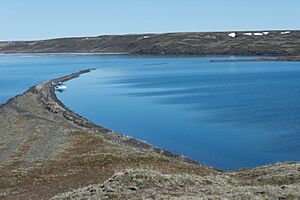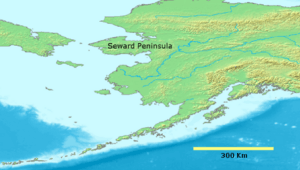Devil Mountain Lakes facts for kids
Devil Mountain Lakes (called Qitiqłiik in the Inupiaq language) are amazing lakes found in western Alaska. They are a type of crater lake known as a maar. A maar is a wide, flat-bottomed volcanic crater that forms when hot magma meets groundwater, causing a huge explosion. This explosion leaves a big hole, which then fills with water to become a lake.
Devil Mountain Lakes are thought to be the largest maars in the entire world. They are part of a bigger area called the Espenberg volcanic field, which has many volcanic features.
Where are the Devil Mountain Lakes?
The Devil Mountain Lakes are located about 100 km (62 mi) (that's about 62 miles) southwest of a town called Kotzebue. You can find them on the northern part of the Seward Peninsula in Alaska. Their exact location is 66°23′41″N 164°29′18″W / 66.39472°N 164.48833°W.
These lakes are quite special because they form a double crater. This means there are two main lakes close together:
- North Devil Mountain Lake: This lake is about 5.1 km (3.2 mi) (around 3.2 miles) across.
- South Devil Mountain Lake: This one is about 3.4 km (2.1 mi) (around 2.1 miles) across.
The entire crater area is about 8 kilometers (5.0 mi) (about 5 miles) wide. The lakes are also part of the Bering Land Bridge National Preserve, which is a protected natural area.
There are other maars nearby too, like the Killeak Lakes (North Killeak Maar and South Killeak Maar) and White Fish Lake (Whitefish Maar). Because of all these maars, the area is sometimes called the "Espenberg Maars."
How the Lakes Were Formed
The Devil Mountain Lakes were likely formed a very long time ago, around 21,000 years ago. This was during the Pleistocene Ice Age, a time when much of the Earth was covered in ice.
During this period, hot lava flowed through the frozen ground, called permafrost. When the hot lava met the ice and water in the permafrost, it caused powerful explosions underground. These explosions created the large craters that later filled with water, forming the Devil Mountain Lakes we see today.
On December 1, 1978, the area became a protected nature reserve called the "Bering Land Bridge National Monument." Its name was later changed on December 2, 1980, to the "Bering Land Bridge National Preserve."



